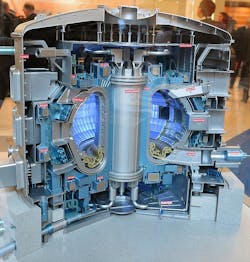What some consider the holy grail of commercial power generation, nuclear fusion, is drawing real-time investment like never before as researchers start to believe they are closer than ever to unlocking the power of the sun.
The Savannah River National Laboratory (SRNL) in South Carolina just announced it is receiving $6 million in funding to lead two projects on expanding the understanding of fusion energy. This work follows groundbreaking projects in the U.S. at the Lawrence Livermore National Lab and the international ITER megaproject in southern France.
The two projects at SRNL are of much smaller scope than ITER, but the key work led by principal investigators Luke Olson and Christopher Dandeneau will focus on challenges in fuel cycle and blanket technologies, and tritium interactions with materials.
“Both projects will develop novel technologies invented at SRNL and provide the resources to increase the technology readiness level of the methods,” said SRNL Advisory Program Manager, Fusion Energy, Brenda Garcia Diaz, in a statement. “The projects engage SRNL partners at other national laboratories and universities that will assist in advancing and demonstrating the technologies.”
Nuclear fusion is unique from nuclear fission used in power plants in that two light atomic nuclei are combined to form a solitary heavy reaction that can promise limitless amounts of energy. The challenge facing researchers for nearly 100 years, however, is how to achieve it in a controlled, sustained and energy net-positive reaction.
Reducing the financial friction in isotope separation
ITER’s thermonuclear reactor, for example, aims to use more than 300 MW of electrical power aimed at the plasma of deuterium and tritium fuel to hopefully generate 500 MW of heat for multiple minutes at a time. The goal is still in the future.
On a smaller, but equally vital scale, the South Carolina lab will try to utilize 2-D material-based hydrogen isotope separation and development and de-risking of Li electrolysis, among other extremely complicated processes to find a pathway to fusion.
“Isotope separation is a slow and expensive process,” principal investigator Dale Hitchcock said in the news release about the award. “Our patented technology using 2D materials to separate hydrogen isotopes could significantly reduce the capital and operational costs associated with tritium processing in a fusion power plant.”
For fusion to be sustainable, the reactors must make and extract their own tritium fuel from the process. Researchers such as Olson and Dandeneau are working on ways to simplify and reduce costs for extracting tritium.
“The scale-up of these tritium separation methods for use in molten metal and molten salt tritium breeders will significantly derisk and improve the technology readiness levels of these SRNL developed methods, said Olson. “They have the potential to significantly simplify and improve tritium separation compared to the status quo.”
Fusion ignition and achieving 1 MW in net fusion
Two years ago, the National Ignition Facilities team at Livermore National Lab in California surpassed the so-called “fusion threshold” of achieving more fusion energy output than was delivered to the plasma target. In that breakthrough example, the team achieved 3.15 megajoules (MJ) of fusion energy from 2.05 MJ aimed at the plasma.
Three MJs is only 1 percent of the energy required from the grid to even power the project’s massive laser systems, so scaling up and commercialization of fusion remains a long way away.
The long race is on, however. Just this fall technology firm Thales and the Max Planck Institute for Plasma Physics reported what they called a new record for net fusion in reaching an output of 1.3 megawatts (MW).
Check out Microgrid Knowledge's E-Book on Nuclear
Prospects for a Small, Modular and Reactive Future
The Massachusetts Institute of Technology’s Commonwealth Fusion Systems spinoff is among the global entities trying to figure out a scalable, commercial fusion methodology. Others working on the challenge include Canadian Nuclear Laboratories, United Kingdom Atomic Energy Authority and the teams at the ITER reactor project.
Nations engaged in the ITER research include members of the European Union, South Korea, Japan, United States, Russia, India and Switzerland.
The sun and stars are powered by nuclear fusion reactions. The promise of fusion energy that is so attractive to energy researchers is it theoretically could generate four times more energy per kilogram of fuel than nuclear fission, according to the International Atomic Energy Agency.
Read the IAEA's Page on Nuclear Fusion
More than $1 billion is being allocated into nuclear fusion research annually, according to Bloomberg New Energy Finance. Forbes predicts that fusion technology ultimately could rise to a $40 trillion market.






